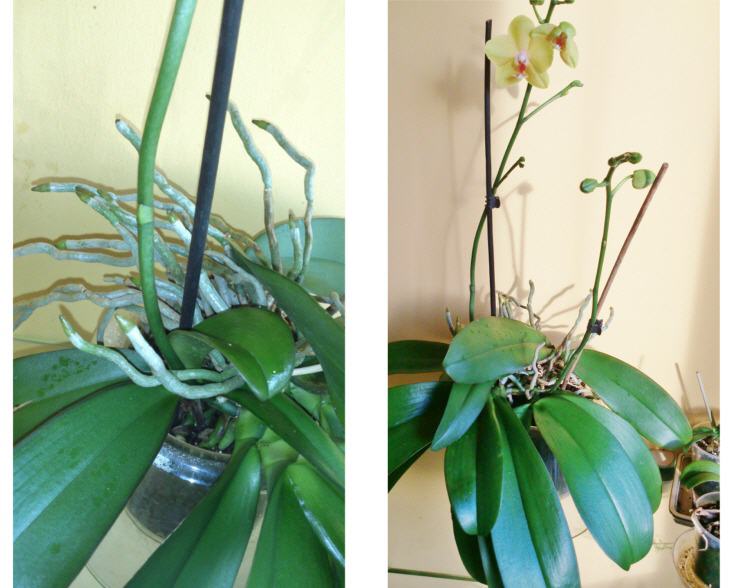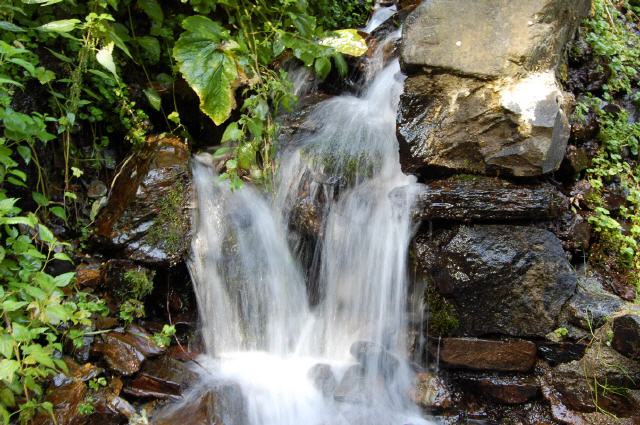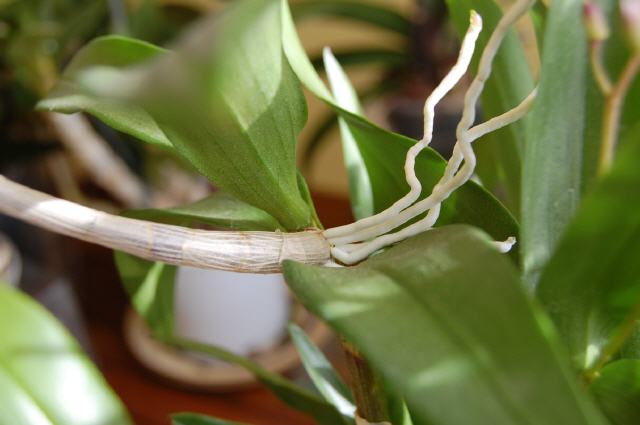Phalaenopsis and care
1 - Introduction
2 - Origins
3 – The plant
4 - Basic care
5 - Advices for flowering and cut rods
6 - Table of basic needs

1- Introduction

The Phalaenopsis constitute surely the family of the most popular and known orchids. Its cultivation and commercialization has spread worldwide and they are easy to find in any center of gardening. In many occasions they come to our home as gift or present of some friend or relative. In this page we will try to explain which are their peculiarities and how to keep them alive and healthy in our home.
2- Origins
These orchids are named for their resemblance to butterflies : " Phalaena = Butterfly " and " Opsis = resemblance ." This name was given in 1752 by the botanist CL Blume noting its resemblance to a kind of tropical moths when they were in flight.
Phalaenopsis are from the Philippines , tropical Asia , Australia and also of some zones of Africa.
As many other species of orchids, phalaenopsis are epiphytes , that is to say , they grow in the branches of trees or among rocks. Therefore, their roots are not made to look for the land but to hold onto any structure or natural support and capture nutrients from rainwater and organic matter that this one is dragging down trees and branches.
3- Plant
Out of their natural habitat, the phalaenopsis are commercialized from different fish-ponds of upbringing by containers of plastic or transparent vinyl and filled with pine bark and other materials that allow an easy drainage and the subordination of the plant. Opaque containers are not recommended because they prevent the coming of the light to the roots and they have an important role in nutrient uptake and , as we have explained, roots are designed to be outdoors . In fact, the plant in its normal growth usually develops aerial roots that point upwards.
In addition, the Phalaenopsis possess from 2 to 6 or more big and pulpy leaves of a very intense green color that can change in their coloration according to the light that they receive. These leaves play an important role in the life of the plant as they are real stores of water and nutrients. Unlike other species of phalaenopsis, they do not have pseudobulbs or rhizome (eg dendrobium ) bodies that are covered by these requirements.
Excessively dark leaves or of the pale green can indicate lack of light.
Finally, the plant generates in the flowering season, one or more floral rods that have their origin normally under the most ancient leaves and in the trunk area. These rods have a darker coloration and their top is lightly sharper with regard to the aerial roots with those who are in the habit of confusing to the beginning of their growth. Later, the floral rods that grow up will need the support of a small guide that we will hold onto.
Detail of the plant and aerial roots:

Detail of the floral rods at the beginning:

4- Basic care
Basic care focus on several key aspects :
1 - Light:
We will need a location with plenty of light (about 10,000 and 15,000 lux at time of flowering ). Avoid direct sunlight , though , to stimulate flowering is very effective to take advantafe of Sun in the evenings ( when the sun is low) filtered by a thin translucent curtain.
2 - Temperature:
The ideal temperature is about 23 or 24 º C. reaching tolerate with good moisture conditions ( the more heat , they require more moisture ) temperatures over 30 º.
The minimum temperature should not drop more than 13-14 º C.
3 - Watering and Humidity:
The plant should be watered avoiding complete dryness of the bark but bearing in mind that these plants do not tolerate water logging neither in the leaves nor in the roots. This leads to diseases (fungi, bacteria , etc. ) and the plant will die.
Excessive dryness period causes dehydration of the leaves ( they wrinkle and take a pale color) and produce their death. These leaves can not be recovered once they are dehydrated so they usually end up getting rid of the plant.
In general phalaenopsis need a humidity level of around 60/70 % while the current specimens that have born and raised in greenhouses have been getting used to levels of humidity lower tan in their natural hábitat. At home, humidity can be maintained at lower levels if we control the oppotune irrigations.
A good way to water them is by dipping the plant into a container for a few minutes . Allow the soil or bark partially dry between waterings.
It is essential not to use tap water. The current waters usually with high hardness and mineral content are not suitable for these plants. You have to use bottled water or water treated with appropriate filters (reverse osmosis ) .
It is also important the waterings incurred by vaporizers on the aerial roots and leaves, preventing waterlogging . Such waterings should be more abundant in the hot season (summer) because there is more water loss.
4 - Nutrients:
Use only special fertilizers for orchids and follow the product instructions. In general, we need to fertilize more regularly in pre- bloom (usually in late winter or early spring in our Mediterranean climate) periods. We recommend also using foliar fertilizers mixed in water vaporization as both aerial roots and leaves can assimilate and contribute to the good general condition of the plant.
5 - Other issues to consider:
Also note that the phalaenopsis, as it happens with the majority of orchids, they do not support to be in a very loaded places ( low oxygen or snuff smoke or other pollutants). They do not tolerate direct airflow although some renovation of the environment (ventilation of stay) either .
Floral rod in full development:

6 - Reproduction
In their natural habitat, phalaenopsis can reproduce by microscopic seeds. This process has been replicated in the laboratory to generate new hybrid species but requires technology and expertise that are beyond the less initiated fans. However, phalaenopsis give us other more simple and direct reproduction : The " keikis " . It consists of the appearance of a floral rod of a small plant ( keiki ) that is an exact copy of the mother plant that produces it.
The process can be stimulated from the cut of a floral rod (over a knot in the average part) and after his(her,your) flowering and later(posterior) fall of flowers. We suggest carefully remove the thin skin that covers the tip of the knot to get this way more light and stimulate the development of the keiki .
Once these roots measure between 3 or 4 centimeters one can proceed carefully to the separation of the keiki of the stem of the parent plant to which they are joined. The following step will be to plant it on a small container with the prepared habitual one of bark. From here we have a new autonomous plant developing.
7 - Transplantation : Changes of substrate
The phalaeanopsis generally comfortable with their compressed roots in a transparent container. In fact this may stimulate flowering. We advise the changes only where we had an infestation of bacteria or fungi in the roots or in cases in which the plant has grown and really need more space.
These changes must take place in the dormant period of the plant. Never during the flowering. We use special preparations substrate for orchids and of a easy acquisition in any center of gardering. Avoid fertilizer in the post- transplant period and excess irrigation . Maintain temperature without much change and away from excessive light. The plant will need a few days to recover from small scars provoked in the roots and other parts . Be alert to possible infestations and extreme hygiene measures.
8 - Diseases and Pests
We recommend visiting our page : Checking for diseases which are the leading causes of illness in our phalaenopsis and how to control them.
Advices if you are buying a phalaenopsis:
If you are going to buy an orchid phalaeanopsis for the frist time and do not know very much in the matter, we advise you that at the moment of choosing your specimen not only should be focus in the flowers. The best indication of which a plant is healthy is the quality of their roots. Roots of a deep green color, they are a good sign of health of the plant and of its possibilities of survival. Observe also the leaves. Distrust if they present black spots, they are wrinkled or have an excessively pale color or with few firmness. We do not advise the purchase of specimens which roots are immersed in artificial products as gel or others. Reject opaque containers.
5- Tips for flowering and cutting sticks:
There are three fundamental factors to encourage a flowering phalaenopsis :
1st / The plant must notice a difference between night and day for a period of time (several weeks). The temperature should be between a minimum of 14 º C. hours at about 20-22 ° C minimum in the morning. This can be achieved naturally in terraces, verandas or balconies covered south facing windows and willingness. The ideal time is late winter, early spring usually occur where these contrasts at least in the Mediterranean climate.
2nd / Increased lighting is necessary. 10,000 lux sufficient under normal conditions must increase to 15,000 lux to encourage the plant. An orientation more adapted with approximation to large windows or taking advantage of the light of the evening in spring can help us. Remember that we must not expose them to the direct Sun an exhibition to the evening light will help us, that type of light that comes from more oblique form and that we can leak lightly with a translucent curtain.
3rd / We can also use specific fertilizers to stimulate flowering. Normally we suggest the proportion of formula : 10-30-20 ( nitrogen - phosphorus ratios - Potassium).
Finally we can carry out vaporizations on the leaves with products that are bio-stimulants of growth and flowering containing synthetic amino acids and vitamin complexes. One of theses products is commercialized in Spain (Vitavid Orchids) by Flower House.
What to do with floral rods once the flowers have lost?
There is no unanimity in the matter provided that we can assure the reaction of the orchid once effected one or another action either. In occasions we surprise the orchids with unpredictable movements.
Two possibilities are contemplated. The first one consists of cutting the floral rod from the base once they has remained without flowers. This will always force to the plant to produce a new rod. The new rods will always give larger and more numerous flowers. This would be one of the arguments for cutting the rod.
The second possibility is to leave the rod as is and hoping the plant decides. In this case it may happen that the rod is finished drying himself and we should cut it, but it can also happen that stays green later and start a floral regrowth from any of their knots . There are fans who cut the rod above the first knot (from below) to stimulate a new outbreak or keiki .
All these options should be valued by every fan and experiment the results.
6- Table of basics needs:
| Conditions: | Information: | Observation: |
|---|---|---|
| Temperature | The maxims can come to more of 30ºC. Not low minims to 13 or 14ºC. | If the temperatura increases (+28-30º) we will have to increase the level of humidity in order to the plant tolerates it better. We will need a light differrence of temperatura between the day and the night to encourage the flowering (at least of 7 or 8 degrees). |
| Humidity | The ideal humidity is from 60 to 70 % fitting to the temperature. More major heat more necessary humidity. | In winter or dormant period we can lower the humidity level (50%). |
| Light | They need bright rooms without direct sun. | To stimulate flowering must increase the light level to 15,000 lux. We can place the plant near windows and enjoy the sun of evening filtered with a translucent curtain. |
| Fertilizer | Add fertilizer for orchids in the water and use it for watering in the growing season (spring-summer). | It is also appropriate use of foliar fertilizers. In winter (dormant period) distancing fertilizers. |
| Substrate | We can install them in small containers with a special substrate for orchids and they have to have a high capacity to filter water (peat, pine bark, etc..). | Transplanting the plant only because of a root disease or when the plant really can not continue to grow. |
| Others | They need good ventilation. Avoid direct airflow. | There is not an especially delicate plant if we are able to provide the conditions needed. Avoid contaminated with organic gases or smoke of any kind places. |
More information about the care of orchids:
 |
 |
 |
 |
 |
Please rate this page by clicking on the icons.


































